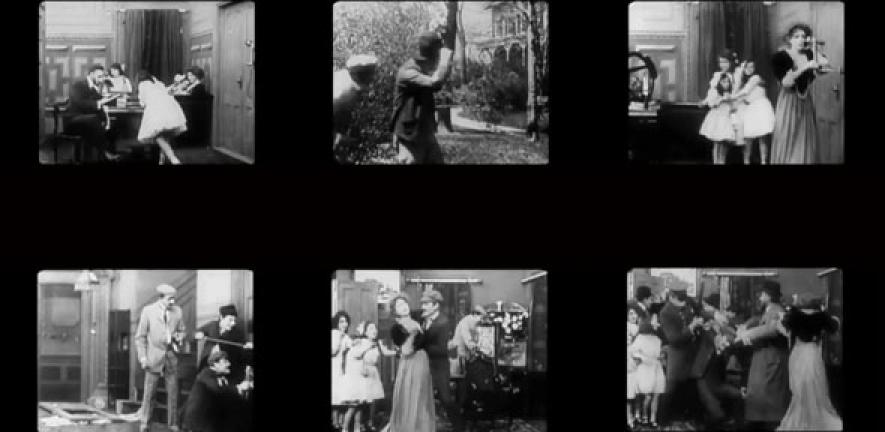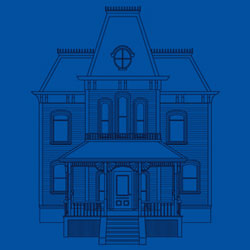
It’s black and white, silent and just short of ten minutes in length. But D.W. Griffith’s 1909 classic The Lonely Villa inspired Dr John David Rhodes, Director of Cambridge’s new Centre for Film and Screen, to look at the role and meaning of the house in American cinema.
It’s black and white, silent and just short of ten minutes in length. But D.W. Griffith’s 1909 classic The Lonely Villa inspired Dr John David Rhodes, Director of Cambridge’s new Centre for Film and Screen, to look at the role and meaning of the house in American cinema.
Houses are built to be lived in but also to be looked at – you only have to switch on your television to see how much they fascinate us.
John David Rhodes
The Lonely Villa tells the story of four women subjected to a terrifying break-in by intruders. A woman barricades herself and her daughters into the house as her absent husband, alerted by a phone call, hastens to their rescue. In the opening shot, the villains are seen lurking in the shrubbery of the handsome all-American home that stands in splendid isolation, an icon of the property-owning dream.
Rhodes’ exploration of the house in American cinema has taken him deep into the history and theory of both film and architecture, and will result in a book due for publication in 2017. He is Director of the newly launched Centre for Film and Screen, which brings together researchers from subjects as diverse as English, philosophy, history of art, architecture and languages, and continues a tradition of teaching and research on the subject of film since the 1960s.
“Houses are built to be lived in but also to be looked at – and you only have to switch on your television to see how much they fascinate us,” he says. “In watching cinema, too, we are forever looking at and into people’s houses. Cinema’s preoccupation with the house stems from cinema’s strong relation to realism and to the representation of human lives, a large portion of which plays out in domestic interiors.”
Central to Rhodes’ research into films that range from Meet Me in St Louis and Gone with the Wind to Psycho and Citizen Kane is the idea of property and possession as well as their opposites – alienation and dispossession. It’s a theme that flows through the cinematic experience right to the temporary possession of the seat in which the viewer watches a film and enters the intimate spaces of other people’s lives. “Property reigns in many aspects of the cinema experience,” he says. “Not just in the drama unfolding on the screen itself but also in the process of film-making, practices of production, distribution and exhibition.”
Rhodes suggests that the pleasure we take in immersing ourselves in the visual and sensual experiences of entering other people’s worlds has an antecedent in country house tours and, most specifically, the collections known as ‘cabinets of curiosities’. Objects acquired to display and impress, these museum-like collections are examples of belonging and, by the same token, of not belonging. “At the heart of visual pleasure is a constant negotiation of property boundaries,” says Rhodes. “It’s a question of mine but not yours – of inviting in yet keeping out.”
Revealed to a chosen few guests, cabinets of curiosities and their modern equivalents speak powerfully of their owner’s taste. A short film titled House: After Five Years of Living (1955) perfectly encapsulates the house as an object of desire and as a container for carefully curated possessions. Directed by designers Charles and Ray Eames, it shows their modernist house – one they designed themselves – in a series of stills that venerate this landmark building and its collection of modern and folk art, textiles and design objects. Neither of its owners appears yet their presence is palpable through the framing, shot by shot, of the house they created to work so beautifully in its Californian context.
Ownership is not confined to buildings but extends to those who live and work in them. Rhodes says that his thesis is implicitly feminist. His forthcoming book will draw attention to the ways in which, in film and in real life, women are forced into uncomfortably close relationships with the home, becoming part of the same parcel of ownership.
An even more tightly binding relationship is played out between servant and home, particularly in the representation of African American slavery in the American South following the Civil War. Two thirds of the way into Gone with the Wind, the servant girl Prissy looks up at her employers’ newly constructed mansion and exclaims: “We sure is rich now!” The viewer is apparently invited to laugh both at her delight and at her naivety, and in a manner that only repeats the film’s explicit racism. Yet the spectator is also the butt of this joke.
“This shot is a kind of ‘hall of mirrors’ of property relations,” says Rhodes. “The cinema audience looks at the image which was Metro-Goldwyn-Mayer’s property. Inside the image, the servants gaze up at the property of the house. But if we look carefully we see that there is no house there: what they are really looking at is either a painted background or else a matt painting inserted in the post-production process. Whether or not the image was there when the scene was shot, what they are looking at is a ‘prop’.”
The word prop is, of course, an abbreviation for property. The house, as the ultimate prop, takes many forms, its physical form acting as a po werful pointer. The mansion and the bungalow, the rambling shingle and stick-style residence, the modernist home with its picture windows: all convey messages (about status, class, race, politics) and shape the action that takes place within them.
werful pointer. The mansion and the bungalow, the rambling shingle and stick-style residence, the modernist home with its picture windows: all convey messages (about status, class, race, politics) and shape the action that takes place within them.
“In much of the US, the possession of land, even if it’s a tiny strip of grass separating one house from another, is fundamental to a feeling of ownership. The bungalow was initially seen as a space for easeful, convenient living – but this modest home quickly came to spell failure,” says Rhodes. “If you think about entrances and exits, a suburban home with a hallway allows for a gradual transition from outside to inside while a bungalow offers none of that dignity. The cramped space of the bungalow leads to too much intimacy and to uncomfortable confrontations.”
Dwelling places are objects of desire – especially so in the affluent Western world. Our homes absorb our money and eat into our time: perhaps, in the process of acquisition, they own us just as much as we own them. As backdrops to our lives, they tell stories about the kind of people we are and would like to be. In film, and on the screen, houses convey multiple meanings – not just about class and status but also about childhood and our relationship with history.
When a house is broken into, a dream is shattered. In Griffith’s The Lonely Villa, the ruffians are hampered by the solidity of the house’s doors and the weight of the furniture pushed up against them. All ends well when the mother and daughters are rescued, just in time, by the man of the house. But property is fragile and, in the final reckoning, all ownership is a question of controlling impermanent and shifting borders.
Inset image: Credit, The District.
Centre for Film and Screen
The University of Cambridge has fostered teaching and research on the subject of film since the 1960s, with pioneering work undertaken in the 1970s-80s by influential figures such as Stephen Heath and Colin MacCabe. Over time, film studies rose in prominence across the University’s faculties. In 2008, Cambridge’s strengths in this subject were consolidated with the launch of the University’s first MPhil in Screen and Media Cultures.
From this heritage of Cambridge’s thoughtful consideration of the art of the moving image, the new Centre for Film and Screen has been developed. Although based mainly in the Faculty of Modern and Medieval Languages, the Centre is truly interdisciplinary, featuring researchers from across subjects as diverse as English, Philosophy, History of Art, Architecture and Languages.
This year, the Centre is launching the University’s first ever PhD programme in Film and Screen Studies, to complement the existing MPhil course and to enable doctoral students to join the active and varied film and screen studies research culture at Cambridge and participate in the Centre’s teaching, research and seminars.
Cambridge itself is a cinematic city. Its architectural beauty and history have, over the years, made it a very attractive location for film production. The city is home to a thriving art cinema and numerous film and arts festivals, including the annual Cambridge Film Festival. Many of the Colleges of the University have film screening programmes and host visiting filmmakers.
The broader culture of the University has long been associated with creativity and dynamism in the arts and humanities, and continues to produce some of the most noteworthy names in the film and television industry, such as actors Tilda Swinton and Tom Hiddleston and director Sam Mendes. Cambridge’s postgraduate degrees in Film and Screen Studies combine the wealth of the University’s humanistic traditions with innovative inquiry into the contemporary culture of the moving image.

The text in this work is licensed under a Creative Commons Attribution 4.0 International License. For image use please see separate credits above.




